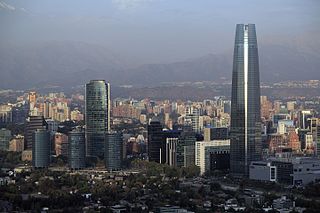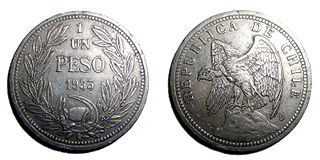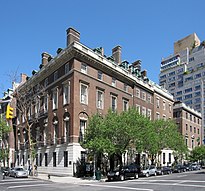
The Economy of Chile is a market economy and high-income economy as ranked by the World Bank. The country is considered one of South America's most prosperous nations, leading the region in competitiveness, income per capita, globalization, economic freedom, and low perception of corruption. Although Chile has high economic inequality, as measured by the Gini index, it is close to the regional mean.

The economy of Mexico is a developing mixed-market economy. It is the 15th largest in the world in nominal GDP terms and the 13th largest by purchasing power parity, according to the International Monetary Fund. Since the 1994 crisis, administrations have improved the country's macroeconomic fundamentals. Mexico was not significantly influenced by the 2002 South American crisis, and maintained positive, although low, rates of growth after a brief period of stagnation in 2001. However, Mexico was one of the Latin American nations most affected by the 2008 recession with its gross domestic product contracting by more than 6% in that year.

The North American Free Trade Agreement was an agreement signed by Canada, Mexico, and the United States that created a trilateral trade bloc in North America. The agreement came into force on January 1, 1994, and superseded the 1988 Canada–United States Free Trade Agreement between the United States and Canada. The NAFTA trade bloc formed one of the largest trade blocs in the world by gross domestic product.

The economy of Peru is an emerging, social market economy characterized by a high level of foreign trade and an upper middle income economy as classified by the World Bank. Peru has the forty-seventh largest economy in the world by total GDP and currently experiences a high human development index. The country was one of the world's fastest-growing economies in 2012, with a GDP growth rate of 6.3%. The economy was expected to increase 9.3% in 2021, in a rebound from the COVID-19 pandemic in Peru. Peru has signed a number of free trade agreements with its main trade partners. China became the nation's largest trading partner following the China–Peru Free Trade Agreement signed on 28 April 2009. Additional free trade agreements have been signed with the United States in 2006, Japan in 2011 and the European Union in 2012. Trade and industry are centralized in Lima while agricultural exports have led to regional development within the nation.

The Free Trade Area of the Americas (FTAA) was a proposed agreement to eliminate or reduce the trade barriers among all countries in the Americas, excluding Cuba. Negotiations to establish the FTAA ended in failure, however, with all parties unable to reach an agreement by the 2005 deadline they had set for themselves.

The "Miracle of Chile" was a term used by economist Milton Friedman to describe the reorientation of the Chilean economy in the 1980s and the effects of the economic policies applied by a large group of Chilean economists who collectively came to be known as the Chicago Boys, having studied at the University of Chicago where Friedman taught. He said the "Chilean economy did very well, but more importantly, in the end the central government, the military junta, was replaced by a democratic society. So the really important thing about the Chilean business is that free markets did work their way in bringing about a free society." The junta to which Friedman refers was a military government that came to power in a 1973 coup d'état, which came to an end in 1990 after a democratic 1988 plebiscite removed Augusto Pinochet from the presidency.
The economic policies of Bill Clinton administration, referred to by some as Clintonomics, encapsulates the economic policies of United States President Bill Clinton that were implemented during his presidency, which lasted from January 1993 to January 2001.

The G-3 was a free trade agreement between Colombia, Mexico, and Venezuela that came into effect on January 1, 1995, which created an extended market of 149 million consumers with a combined GDP of US$486.5 billion. The agreement states a ten percent tariff reduction over ten years for the trade of goods and services among its members. The agreement is a third generation one, not limited to liberalizing trade, but includes issues such as investment, services, government purchases, regulations to fight unfair competition, and intellectual property rights.
The fast track authority for brokering trade agreements is the authority of the President of the United States to negotiate international agreements in an expedited manner and with limited congressional oversight. Renamed the trade promotion authority (TPA) in 2002, the TPA is an impermanent power granted by Congress to the President. It remained in effect from 1975 to 1994, pursuant to the Trade Act of 1974 and from 2002 to 2007 pursuant to the Trade Act of 2002. Although it technically expired in July 2007, it remained in effect for agreements that were already under negotiation until their passage in 2011. In June 2015, a third renewal passed Congress and was signed into law by President Barack Obama.
The North American Competitiveness Council (NACC) was an official tri-national working group of the Security and Prosperity Partnership of North America (SPP). It was created at the second summit of the SPP in Cancún, Quintana Roo, Mexico, in March 2006. The SPP is an agreement between the leaders of the United States, Canada and Mexico to work towards a more integrated North American economy and security region. Composed of 30 corporate representatives from some of North America's largest companies, the North American Competitiveness Council has been mandated to set priorities for the SPP and to act as a stable driver of the integration process through changes in government in all three countries.

Historically speaking, bilateral relations between the various countries of Latin America and the United States of America have been multifaceted and complex, at times defined by strong regional cooperation and at others filled with economic and political tension and rivalry. Although relations between the U.S. government and most of Latin America were limited prior to the late 1800s, for most of the past century, the United States has unofficially regarded parts of Latin America as within its sphere of influence, and for much of the Cold War (1947–1991), actively vied with the Soviet Union for influence in the Western Hemisphere.

The United States is party to many free-trade agreements (FTAs) worldwide.
Integration is a political and economic agreement among countries that gives preference to member countries to the agreement. General integration can be achieved in three different approachable ways: through the World Trade Organization (WTO), bilateral integration, and regional integration. In bilateral integration, only two countries economically cooperate with one another, whereas in regional integration, several countries within the same geographic distance become joint to form organizations such as the European Union (EU) and the North American Free Trade Agreement (NAFTA). Indeed, factors of mobility like capital, technology and labour are indicating strategies for cross-national integration along with those mentioned above.

The Southern Common Market, commonly known by Spanish abbreviation Mercosur, and Portuguese Mercosul, is a South American trade bloc established by the Treaty of Asunción in 1991 and Protocol of Ouro Preto in 1994. Its full members are Argentina, Brazil, Paraguay, and Uruguay. Venezuela is a full member but has been suspended since 1 December 2016. Associate countries are Bolivia, Chile, Colombia, Ecuador, Guyana, Peru, and Suriname.
North American integration is the process of economic and political integration in North America, particularly integration of Canada, Mexico, and the United States.
Canadian mining in Latin America and the Caribbean began in the 20th century. Latin America and the Caribbean's vast resources give the region great geopolitical importance, attracting foreign interest for centuries. From the colonial race of European empires, to the multinationals of today's neoliberal capitalist world, this region continues to draw interest. Canada's involvement in Latin America increased dramatically since 1989 with several landmark negotiations and agreements. By 2009, the Canadian larger-company mineral exploration market in this region was valued at US$1.7 billion.
Between 1967 and 2016, the Emergency Committee for American Trade (ECAT) was a U.S. trade body representing U.S.-based international business enterprises from the principal sectors of the U.S. economy..

The North American Free Trade Agreement of 1994's effects on Mexico have long been overshadowed by the debate on the Agreement's effects on the economy of the United States. As a kind partner in the agreement, the effects that NAFTA has had on the Mexican economy is essential to understanding NAFTA on a whole. A key factor in this discussion is the way the Agreement was presented to Mexico; namely, that it would increase development of the Mexican economy by providing more middle class jobs that would enable more Mexicans to lift themselves out of the lower classes. Thus, wages, employment, attitudes, and migration all present essential areas of analyses to understand effects NAFTA has had on the Mexican economy.

The Agreement between the United States of America, the United Mexican States, and Canada (USMCA) is a free trade agreement between Canada, Mexico, and the United States. It replaced the North American Free Trade Agreement (NAFTA) implemented in 1994, and is sometimes characterized as "NAFTA 2.0", or "New NAFTA", since it largely maintains or updates the provisions of its predecessor. USMCA created one of the world's largest free trade zones, spanning roughly 500 million people and totaling over $26 trillion in GDP (PPP).













